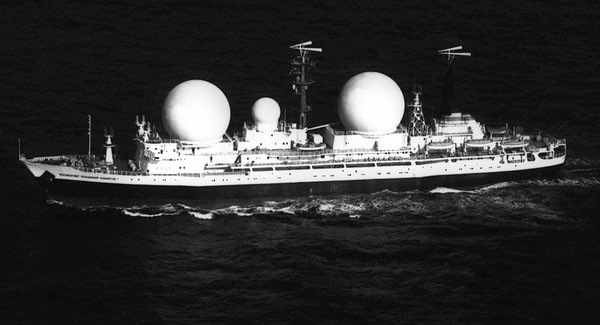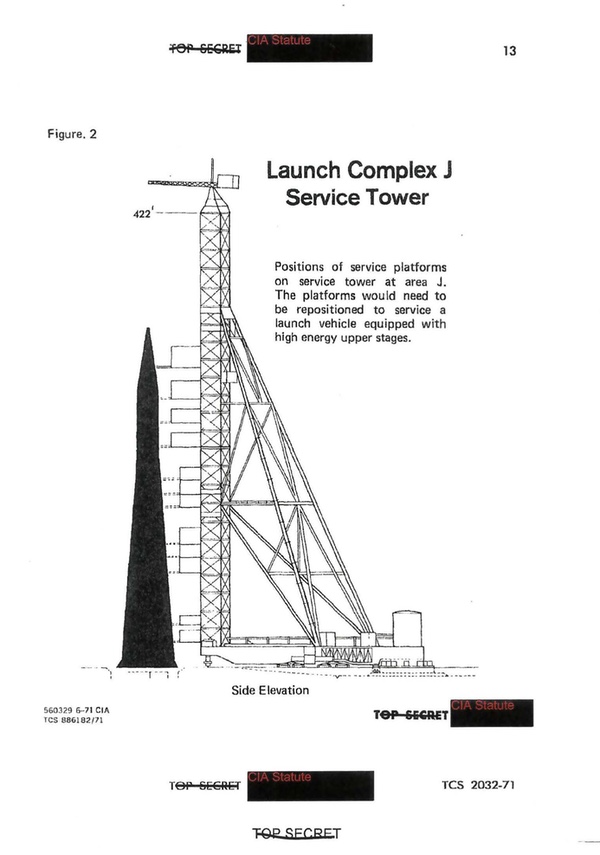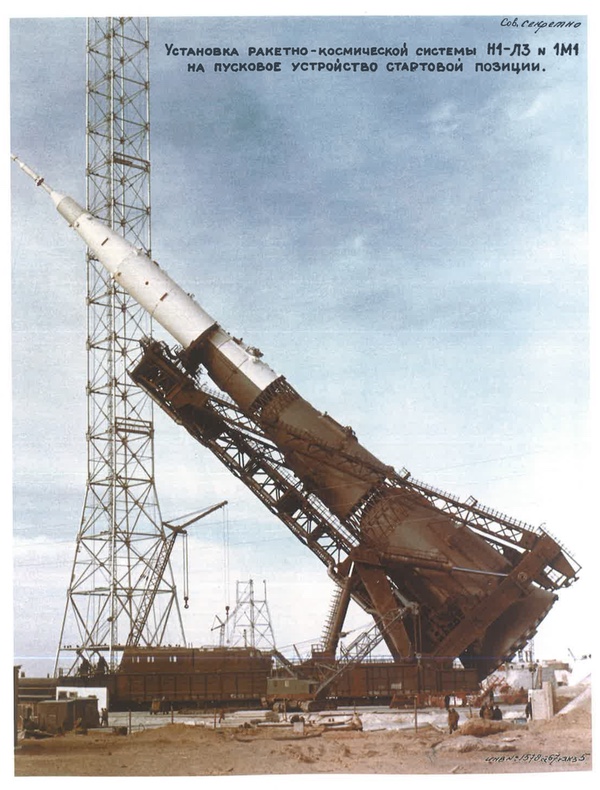Peeking behind the iron curtain: National Intelligence Estimates and the Soviet space programby Dwayne A. Day
|
| Starting in 1962, the CIA produced an NIE on the Soviet space program every couple of years, and space historians have found them to be highly useful insights into what US intelligence officials knew, or thought they knew, about the Soviet space program. |
The first NIE titled The Soviet Space Program was published in December 1962. Subsequent estimates followed in 1965, 1967, 1969, 1971, 1973, 1983, and 1985. In the words of the late Jeffrey Richelson, “The estimates focused on ground facilities, launch vehicles, space systems (particularly military systems), lunar activities, scientific and technical capabilities, and planetary probes. Those estimates reflected both the growing Soviet space program and increasing U.S. intelligence capabilities to monitor and understand such activities.”
These NIEs on the Soviet space program during the Cold War were declassified and released in the 1990s. They proved to be highly useful for understanding what the United States knew about Soviet activities during the space race. These NIEs indicated that the US intelligence community had tremendous and very capable resources focused on the Soviet space program during this period. Looking back on this period with historical hindsight, it is now apparent that there was very little in the NIEs that we now know to be either missing or wrong.
Both the 1969 and 1971 NIEs were originally released in the 1990s (those earlier versions can be found here: 1969, 1971). They represent the period when the Soviet Union was launching its N1 rocket. Both documents released in the 1990s were substantially intact, although they had text and some images deleted—“redacted”—throughout. Naturally, anybody reading these declassified versions in the 1990s wondered what information was so sensitive that it still had to be deleted three decades later. The 1969 and 1971 NIEs were submitted for further declassification review in 2011. Recently, the government released new versions of the 1969 and 1971 NIEs. It is now possible to see some of what had been previously deleted.
 The space event ship Komarov was used to support Soviet lunar missions. In addition to following its movements at sea--when and where it went indicated possible space launches—the US intelligence community also paid close attention to what equipment it used. The addition of comsat antennas indicated that the ship was using satellites to relay information back to the Soviet Union. |
The 1969 NIE
The 1969 NIE was published as a top-secret document in June 1969. When first released in the 1990s, not much of it was redacted. Unfortunately, after the recent review, not much new material has been released.
One small section that was previously deleted has now been partially declassified. It mentions that Molniya comsats played some role in the Soviet lunar effort, and linked the space event ship Vladimir Komorov to Moscow during manned space events.
Another newly declassified paragraph concerns Soviet reconnaissance satellites:
“During the past two years, the Soviets have tasked satellites in response to several military-political crisis situations. Soon after the Arab-Israeli war, Soviet satellites obtained extensive coverage of the Middle East and eastern Mediterranean. In the months just prior to the invasion of Czechoslovakia, Soviet satellites were used for unprecedentedly extensive coverage of Rumania, Czechoslovakia, Bulgaria, Hungary, and Yugoslavia.”
Exactly how the US intelligence community knew what the Soviet Union was looking at with its satellites is not stated in the NIE, but any knowledgeable reader at the time would have concluded that the Soviets were using satellites to spy on their own neighbors out of concern that the “Czech Spring” might be spreading.
| Other new text indicates that the CIA did not think much of Soviet electronic intelligence gathering equipment. |
The report noted that Soviet low-resolution reconnaissance satellites also included electronic intelligence gathering equipment. Newly released text states that, “During this period there has been a noticeable shift in the targeting for collection.” Several following sentences, undoubtedly explaining what the new targets for electronic intelligence collection were, remain deleted.
Other new text indicates that the CIA did not think much of Soviet electronic intelligence gathering equipment: “Our evidence indicates that present Soviet electronic reconnaissance systems are very limited and collect only very general information. We believe most collection is crude order of battle information such as the number of transmitters acting in selected frequency bands in various geographic locations.” At least one more sentence on that topic remains classified.
The earlier released version of the 1967 NIE indicated that the Soviets had enhanced their spacecraft electronic systems for tracking and data acquisition from near Earth orbit out to the vicinity of the Moon. What those new systems were capable of doing was previously deleted, but the newly revealed text states, “Among the functions that have been identified are Doppler tracking, range tracking, telemetry, command, programming, voice communications, and television.” Previously, the document had indicated that all those modes had been tested during the Zond lunar missions in 1968 but deleted the fact that the television mode had not been tested. It also added a new sentence: “The command, tracking, and television modes were used during the Soyuz program.” Clearly, when Vladimir Komarov flew on his fatal Soyuz mission in April 1967, US intelligence assets were listening in, and gathering up the television signals from the spacecraft.
The earlier version of the NIE included text stating that, “The Soviets near Earth command and control network has improved during the past year…” but deleted text that has now been released: “ground-to-spacecraft communications need improvement.” But one short line, which may have indicated how the CIA knew that, remains deleted.
Another section of the report concerned the space event tracking ship Cosmonaut Vladimir Komarov. Newly released text indicates what the Komarov was doing: “The primary mission of the Komarov has been monitoring the lunar vehicle data system and transmitting commands from the Western Hemisphere. The Komarov has been stationed at Havana for circumlunar flights where it serves as a relay station and supplements the facilities at Yevpatoriya and Golenki, making possible 24-hour coverage of a lunar mission.” That coverage was first achieved for the Zond 5 mission in September 1968. Obviously, the US intelligence community was keeping close tabs on the Komarov’s movements, often dispatching a US Navy vessel to follow it around. Finally, the report noted that the Soviets had converted four timber-carrying ships to monitor space events. They had a new antenna system. Newly revealed text indicates that the CIA concluded that the antennas were for receiving telemetry from spacecraft.
 Artist depiction of the N1 rocket, which the CIA referred to as the “J-vehicle,” and its launch pad. This image appeared in the 1971 National Intelligence Estimate on the Soviet Space Program. US intelligence assessments of the Soviet space program were increasingly accurate by the early 1970s. (credit: Declassified National Intelligence Estimate) |
The 1971 NIE
The 1971 NIE was published as a top-secret document in July 1971. Like the 1969 document, the new version only reveals relatively small amounts of new text. It is hard to understand why sentences such as the following were ever redacted in the first place: “Only a small portion of the R&D activity connected with any new systems is susceptible to collection by present intelligence resources.” That seems to be axiomatic. Research and development doesn’t become visible to monitoring until it reaches the full-scale testing phase—Internet hacking was not available back then, so stealing research files off of computers was not an option. Similarly, it is hard to understand why the following sentence was deleted from the NIE in the 1990s but is releasable now: “We are unable to make a confident prediction of expenditures after about 1975 because we can only speculate upon the hardware that may be used that far into the future.” Why the authors considered four years to be “far into the future” is mystifying.
| All four launches were unsuccessful. The US intelligence community missed the February 1969 launch. But clearly, as this new text indicates, they suspected that a launch was about to occur. |
On the subject of the Soviet Union’s huge N1 Moon rocket, the newly released text simply states, “All estimates of its capabilities have been made from photography of the launch vehicle and its related facilities.” That text strongly indicates that the US intelligence community lacked both human intelligence and telemetry intelligence from the launches. Considering that the February 1969 N1 launch was completely missed by US intelligence assets, and the July 1969 launch blew up above the pad (and was too big to be missed, showing up in satellite photos and probably on seismic sensors), that is not surprising. The third flight took place in late June 1971 and the document states that it flew for only 50 seconds before it ended in failure, indicating that the US intelligence community was monitoring that flight in some way. But only if the vehicle flew much further could US intelligence assets start to collect its signals.
Another bit of text on the N1 from later in the document states, “All estimates of the vehicle’s capabilities have been made from photography and have assumed conventional propellants and probable state-of-the-art engine technology.”
There is a bit of new information: “The Soviets appeared to be planning to launch this system for the first time on 22 February 1969 but canceled it for unknown reasons.” The Soviets launched the N1 four times: twice in 1969, and then once in 1971 and again in 1972. All four launches were unsuccessful. The US intelligence community missed the February 1969 launch. But clearly, as this new text indicates, they suspected that a launch was about to occur. In later documents, the intelligence analysts still only refer to three N1 flights. (For more on the US intelligence community and the February 1969 N1 rocket failure, see: “A Taste of Armageddon (part 1),” The Space Review, January 3, 2017, and “A Taste of Armageddon (part 2),” The Space Review, January 9, 2017.)
Another minor release concerned Soviet efforts to develop new “toxic propellants,” particularly fluorine compounds. The newly released text states “Some types of tests have already been conducted.” Another sentence or two, undoubtedly providing details of what the US detected, remains deleted.
Some of the newly released text and the remaining deletions almost seem designed to taunt or be coy. For instance, much of a paragraph on development of high-energy upper stages—a Soviet technology weakness at the time—remains deleted, except for a few words that reveal that the Soviets had built a new railway car for transporting cryogenic materials and had been spotted (presumably by satellite) at the Baikonur launch site. There’s no way to know what remains deleted in that paragraph, but perhaps it referred to where the rail car originated before heading to the launch site.
Other new reveals are minor, but nevertheless give an indication of the kinds of mundane details that intelligence analysts sometimes consider important. For instance, one section describes the Molniya 2 communications satellites, and newly released text indicates that comsat antennas were recently installed on new space event support ships, indicating “that the Molniya system will continue to be used for communications support during future lunar and manned Earth-orbit operations.” Naturally, these would have been prime targets for US communications intelligence operations.
This is followed by another bit of newly released text: “The construction of comsat ground stations at 12 ICBM complexes and of a comsat facility at a Strategic Rocket Forces (SRF) communication control station shows that the Soviets will use comsats to support SRF command and control communications.”
In another section on the Molniya 1 comsat, the newly released text states, “The channel capacity of the system is significantly less than it could be considering the radio frequency at which Molniya I operates and the amount of spacecraft power the Soviets claim is being used.”
| After all these years, it is still slightly disappointing that some portions of these NIEs remain classified. |
Another section concerns the CIA’s assessment of Soviet photo-reconnaissance satellites. The newly released text reveals that there was an aspect of the Soviet higher resolution system that was still unknown: “Our uncertainty as to how this system functions, whether it is a framing type system or a panoramic one, precludes a precise determination of the swath width that is achieved.”
At another point, the newly released text states “we believe that the Soviets are developing two variants of a Navsat program, one for civil use and one for military application.” The Soviets did in fact develop two systems. It is unclear why somebody reviewing the document for release during the 1990s considered the prediction that would happen to be so sensitive it could not be released. Perhaps they deleted that text in error.
Time marches on—slowly
After all these years, it is still slightly disappointing that some portions of these NIEs remain classified. Perhaps, if we are all willing to wait another 20 years, we’ll get to read the rest.
Note: we are using a new commenting system, which may require you to create a new account.
